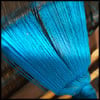Even a casual observer of the Jewish world today will note that a small (but growing) minority of Jewish men have begun affixing blue threads on their tzitzit.
Why has this only begun recently, and why have the vast majority of religious Jews not adopted this practice? The answer lies in a fascinating history, references from the Talmud, and a relatively recent debate within the Jewish community. Ready to unravel the mystery? Let’s begin.
In This Article
- The Mitzvah of Techelet and When It Disappeared
- The Quest for Techelet
- The (Non) Response
- The Time Is Not Right
- Lack of Tradition
- When In Doubt…?
- The Pitfalls of the Wrong Blue
- The Curse of “Kala Ilan”
- Why It’s So Hard to ID the Chilazon
- Archeological Evidence?
- What Color Is It Anyway?
- Why Not Compare to Indigo?
- Can You Catch a Snail?
- Chemical Test
The Mitzvah of Techelet and When It Disappeared
The Torah tells us that the tzitzit (fringes) worn by Jewish men should include a thread of techelet on each corner of the garment.1
The sages teach that the techelet was blue,2 reminiscent of the heavens. The blue dye was extracted from the blood of a sea creature known as the chilazon. Even in ancient times, this creature was very rare, surfacing once every 70 years, which made its dye quite expensive.3
Sometime after the Jewish community was dispersed from the Holy Land, the exact identity of the chilazon and the process to extract the dye were lost. For well over a thousand years, tzitzit have been made solely with white fringes.
The Mishnah, however, is clear that even without the blue thread, one still fulfills the mitzvah of tzitzit with white threads. But if techelet is available, it should be included.4
The Quest for Techelet
In the past two centuries, efforts to rediscover the chilazon and revive the production of techelet have gained momentum.
In 1887, Rabbi Gershon Henoch Leiner, known as the Radziner Rebbe, published Sefunei Temunei Chol, advocating for rediscovering techelet. He even traveled from Poland to Naples, Italy, in 1889, to study sea life in the city’s new aquarium. After a year of study, he identified the inkfish, Sepia officinalis, which is similar to a squid and sometimes called the cuttlefish, as the long-lost chilazon, and he developed a method to produce a deep blue dye from its brown ink. His followers and others quickly adopted the practice of wearing blue strings on their tzitzit, but the practice didn’t gain widespread acceptance.
Why? Some doubted the inkfish was the correct source.
The most significant challenge came from Rabbi Yitzchak Isaac HaLevi Herzog (later to become Chief Rabbi of Israel). In 1913, he published his doctoral dissertation on "Hebrew Porphyrology," in which he reported that he had the Radziner Rebbe’s dye analyzed by European labs and found that its blue color was due to chemicals added during the dyeing process, not the sea creature itself. This, he argued, meant it couldn't be authentic techelet.5
Rabbi Herzog believed the Murex trunculus snail was most likely the chilazon, but he hesitated to confirm it because the snail produced a purple dye, not blue. Instead, he proposed that the Janthina snail (Janthina janthina) might be the chilazon, but the matter remained unresolved.
In 1985, long after Rabbi Herzog's death, researchers discovered that sunlight exposure during the dyeing process could turn the Murex dye from purple to sky blue. This sparked great excitement, as many heralded this find as an important step in rediscovering techelet and restoring this mitzvah to its full glory.
Additionally, archaeological excavations at sites such as Tel Shikmona and Tel Dor in Israel uncovered dyeing facilities with large quantities of Murex snail shells dating back to the biblical period. Chemical analyses of dye residues on pottery shards and textile fragments from these sites confirmed the presence of indigotin, the blue dye component produced by the Murex snail. Textiles dyed with a blue and purple color consistent with Murex dye have been found in archaeological sites across the Mediterranean, including in Israel, Egypt and Greece.
The (Non) Response
Despite these discoveries, most of the Orthodox community continues to wear only white tzitzit. But why? It’s not due to inertia or lack of care, as these are people who are willing to go to great lengths, both physically and financially, to do a mitzvah in the best possible way.
So why hasn’t the community embraced the prospect of using authentic blue-dyed threads for their tzitzit, as we did from the biblical era through the Talmudic times?
The Time Is Not Right
Many6 point to Midrashim that say the chilazon was “hidden” after the destruction of the Temple and will only be revealed in messianic times.7
The Arizal8 explained that techelet does not exist during the time of exile since it represents a high spiritual level that we cannot achieve now.
In a letter9 written by Rabbi Sholom Dovber of Lubavitch, the Rebbe Rashab, to Rabbi Mordechai Yosef Leiner, son and successor of the Radziner Rebbe, the Rebbe Rashab thanks Rabbi Leiner for sending him his father’s books and then writes:
I cannot agree with the core issue because the Alter Rebbe [author of the Shulchan Aruch Harav] wrote in Likkutei Torah,10 citing the [Arizal in] Pri Etz Chaim,11 that techelet does not exist during the time of exile since it represents a high spiritual level that we cannot achieve now.
He explains that this is analogous to certain mitzvahs that we don’t perform these days, such as blowing the shofar when Rosh Hashanah coincides with Shabbat. Now, the technical reason for not using techelet is very different from not blowing the shofar on Shabbat, but the inner reason is the same: The spiritual conditions are not right.
The rabbis give us both a practical and kabbalistic reason for not blowing the shofar on Shabbat. Practically, we want to avoid carrying the shofar in the street. But the Kabbalists explain that the deeper reason is that during the exile Shabbat itself accomplishes what the shofar (nowadays) does. The real reason is the kabbalistic one, but to avoid making rulings based solely on Kabbalah, the Talmud gives a halachic reason.
Similarly, not using techelet has both a practical and a kabbalistic reason. Some give the practical reason that people might put woolen threads of techelet on a linen garment, which is only permissible if the techelet is genuine, and we cannot be sure of that. The kabbalistic reason, as mentioned above, is that we cannot attain what techelet represents while we are in exile, so we shouldn’t wear it. In other words, it isn’t yet the time for it.
According to this, many (including the Rebbe12) have eschewed the prospect of finding the true techelet nowadays.13
Lack of Tradition
Rabbi Yosef Dov Soloveitchik (1820–1892), known as the Beit HaLevi, asserted that the inkfish could not be considered the source of techelet due to the lack of mesorah, a carefully transmitted tradition. The same reasoning would apply to any subsequent species possibly identified with techelet.
His great-grandson, Rabbi Yosef Dov Soloveichek, who was the head rabbi of REITS at Yeshiva University, explained that for a mitzvah requiring a specific item, one must have a mesorah to confirm its identity. Research, analysis, and even compelling evidence cannot replace this tradition. Thus, we must await Elijah the Prophet, who will tell us the identity of the chilazon.14
When In Doubt…?
Some contend that even if the identity of the dye is questionable, it should still be used because of the rule that safek deorayta lechumrah, when there is a doubt if you’ve done a biblical mitzvah, you err on the strict side and do it, especially if there is no downside. For example, if you’re not sure whether you recited Grace After Meals, which is mandated by the Torah, the halachah is that you recite it again just in case.
So why don't we wear these blue fringes “just in case”?
- Many argue that this is not a case of doubt. Rather, it’s a lack of knowledge, which is treated differently.15
- Secondly, there may be a downside (as mentioned above and as we will elaborate below). There are halachic and kabbalistic pitfalls to wearing blue woolen threads that are not techelet.
- Additionally, some contend that this rule only applies if you’re certain that you’ll fulfill the mitzvah by doing the action. (In the example above, once you say Grace After Meals again, you can be certain that you’ve performed the mitzvah.) In our situation, even after affixing the threads, you’re still in doubt. It wouldn’t help to wear several garments, each with its own type of blue, as there have been many candidates for the chilazon so far, and there is no reason to say that another one won’t pop up.
- Lastly, and perhaps most importantly, many contend that this is not a case of doubt, since none of the candidates fit comfortably with all the signs and identifications of the chilazon (more on that later).
The Pitfalls of the Wrong Blue
As we mentioned, wearing the wrong blue has downsides.
According to the Code of Jewish Law, some teach that if you place blue (or any other color) threads that are not techelet on a white garment, you don’t fulfill the mitzvah of tzitzit. The Code of Jewish Law rules that although the final halachah doesn’t follow this opinion, you should make every effort to use white strings in order to fulfill the mitzvah of tzitzit according to all opinions.16
So if your chosen blue is not the true techelet, at the very least, you would not fulfill the mitzvah of tzitzit in the ideal way, and according to some, you would not fulfill it at all.
The Curse of “Kala Ilan”
The Talmud tells us that G‑d will “exact punishment” from one who hangs ritual fringes dyed with kala ilan dye on his garment and says it is techelet.17
In other words, there is a unique punishment or “curse” for one who uses fringes dyed with fraudulent techelet.
Of course, the Talmud can be read to specifically refer to someone who uses the wrong blue with the intention of tricking others. It can also be argued that the Talmud’s ire is reserved for one who uses kala ilan (which many identify as indigo but is itself a matter of debate), not the wrong fish.
Others, however, are of the opinion that it applies to anyone wearing non-authentic techelet. What is so horrible about using the wrong dye that it merits a special curse?
Chacham Yosef Chaim of Baghdad, known as the Ben Ish Chai, explains that in general, negative spiritual energies (sitra achra) attach themselves to the color of techelet. Authentic techelet is holy and can ward off these evil energies.18 Thus, the “curse” would attach itself to any blue threads that are not actual techelet.
Why It’s So Hard to ID the Chilazon
The sages give various signs regarding the identity of the mysterious chilazon. As we we’ll see, some of the candidates for the chilazon align with the signs more than others, but none of them align with all of the signs. This explains the challenge (as well as apprehension) to identify the authentic chilazon with certainty.
Note that these are just some of the many issues that have been raised.
The Talmud states:
This chilazon’s body resembles the sea, its form resembles that of a fish, it emerges once in 7019 years, and with its blood one dyes wool techelet for ritual fringes. It is scarce, and therefore it is expensive.20
While the Murex snail was used for dying, one would be hard-pressed to describe it as “resembling a fish.” Conversely, the inkfish, which is not actually a fish, does seem to fit the bill.
On the other hand, none of the various candidates are known to “emerge once in 70 years.”21
Archeological Evidence?
As mentioned, the remains of many Murex shells have been discovered at ancient dying centers. Doesn’t this indicate that this was the source of techelet? Not necessarily. It has been well-documented that Murex was used to dye the color argaman, a reddish-purple dye (commonly identified as Tyrian Purple) also used in the Tabernacle along with techelet, and generally reserved for nobility, which was much more common than blue techelet. Thus, these factories may have been used just for argaman and not techelet.
As we said, if the Murex dye was produced away from sunlight, it turned purple rather than blue.
In fact, some historical records primarily associate the Murex snail with the production of purple dye rather than blue dye, seemingly implying its primary use was for argaman. In other words, finding archeological evidence that a certain species was used as a dye does not necessarily prove that it is the chilazon from which techelet was produced.
What Color Is It Anyway?
In his description of the techelet-making process, Maimonides asserts that the unprocessed blood of the chilazon is black.22 Conversely, the Murex trunculus gland used for dying is clear when it’s removed and only changes color afterward.
Interestingly, although the final color of techelet is often described as sky blue, there are actually a number of different opinions regarding the true (final) color of techelet. For example, Rabbi Shlomo Yitzchaki, known as Rashi, describes it as a greenish color close to the color of a leek.23
Why Not Compare to Indigo?
Some argue that the true color of techelet should be identified by simply comparing it to the dye produced by kala ilan mentioned earlier. The argument is straightforward: if there is a clear warning against using a "fake techelet" made from a dye that looks nearly identical to real techelet, then one can determine the correct color by examining kala ilan.
Now, even if kala ilan is equated with the indigo-producing woad plant or Isatis tinctoria, as Maimonidies does,24 there is an inherent ambiguity as to the final color produced.
The depth of any dye depends on various factors, such as the concentration of the dye solution, the quantity of textile, the duration of dyeing, and the temperature of the dye bath. Indigo dye can range from light tints to very dark shades, nearly black, depending on these factors. Therefore, the variety of tints and shades of blue produced from kala ilan cannot serve as an indicator of techelet's coloration.
Additionally, indigo-producing plants also contain a significant amount of indirubin, a red dye. Depending on how woad is processed, the dye can have a mixture of both indigo and indirubin. As a result, the color may not be purely blue but rather a bluish- or reddish-purple.25
Can You Catch a Snail?
The Talmud states that one who trapped the chilazon on Shabbat has transgressed the biblical prohibition of hunting on Shabbat and must bring a sin offering.26
According to halachah, the biblical prohibition of trapping creatures on Shabbat does not include catching a sick, lame or injured animal that cannot flee. Such an animal is considered already “caught” and available for possession. Similarly, capturing a slow-moving animal such as a snail27 is not prohibited by Torah law.28
Thus, it would appear that the chilazon, whose trapping is Biblically forbidden, is not a slow-moving animal like a snail.
Chemical Test
As mentioned above, the Talmud29 curses those who make false techelet from kala ilan — i.e., plant indigo. Proponents of the Murex point out that the blue dye produced by indigo (kala ilan) is chemically identical to the dye produced by the Murex.
However, as others point out, this may actually be evidence to the contrary. The Talmud30 provides a chemical test to distinguish between true and false techelet. If it is chemically indistinguishable, then seemingly Murex is also not true techelet.
May we merit the coming of the Moshiach, when we will once and for all be able to positively identify the true techelet and perform the mitzvah of tzitzit in its entirety!









Join the Discussion